L2: Language as uniquely human capacity
1/26
There's no tags or description
Looks like no tags are added yet.
Name | Mastery | Learn | Test | Matching | Spaced |
|---|
No study sessions yet.
27 Terms
What are Chomsky’s 3 theories about language acquisition?
I-language (internal language)
Universal Grammar
Innatism
What is I-language?
mental representation of a person's knowledge of their language
What is universal grammar?
all humans are born with an innate set of grammatical principles shared across all languages
acts like a blueprint for language learning, explaining why children can learn complex languages quickly and uniformly, despite limited input
What is innatism?
certain ideas, knowledge, or capacities are inborn rather than acquired through experience
language ability is hardwired into the human brain
What are the two domains language is divided into?
FLB (broad-sense) → sensory-motor and conceptual systems
FLN (narrow-sense) → recursion (computation)
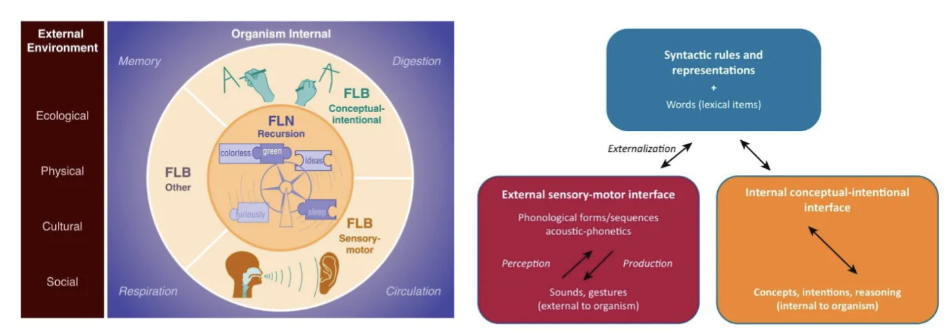
What is faculty of language?
the biological capacity humans have to acquire, understand, and use language
It's a term often associated with Noam Chomsky and his theories on how language is rooted in human cognition
Language is not just speech or communication — it is a cognitive system composed of:
A computational core (syntax/recursion)
Interfaces with thought and sensory-motor systems
Only humans seem to possess the full package (FLN), though parts (FLB) are present in other animals.
RIGHT DIAGRAM:
Syntactic Rules and Lexical Representations (Blue Box)
Internal grammar system that creates structured sentences
Combines with vocabulary (lexical items)
Internal Conceptual-Intentional Interface (Orange Box)
Deals with meaning, reasoning, and intention
Where thoughts are formulated before being put into language
External Sensory-Motor Interface (Red Box)
How language is perceived and produced (e.g., speech, sign, hearing)
Converts linguistic structures into physical signals (and vice versa)
→ Arrows show bidirectional flow: We understand language by mapping sounds/gestures back to structured meanings, and we produce language by mapping thoughts into words and sound

What is evidence for and against language being innate to humans? (3)
Pro:
poverty of stimulus (speakers know what is wrong without exposure to it)
people have a sense of what is and isn’t correct with little input and corrections
Con:
it is not falsifiable (explanations from linguists are post-hoc)
linguistic changes vs genetics
fast-changing languages incompatible with a slow-changing genetic hardwire
What are the 3 hypotheses for the origins of the faculty of language Broad-sense? (FLB)
FLB is homologous to animal communication
FLB is an adaptation, and only present in humans
FLB is homologous to animals, FLN (narrow-sense) is uniquely human
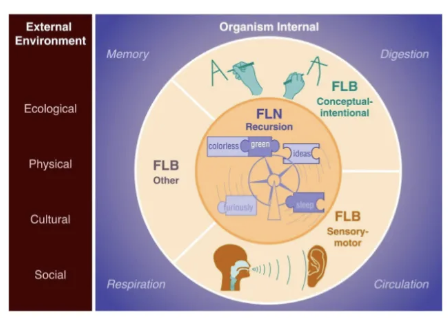
What is Faculty of Language in the Broad Sense (FLB)?
Includes general cognitive abilities that aren’t specific to language but are involved in it, like memory, pattern recognition, and the ability to learn from experience.
Some animals might share parts of FLB (like communication or pattern recognition skills), but not in the same way humans do.
Includes sensory-motor systems (speech, hearing, gesture) and conceptual-intentional systems (thought, meaning, planning)
Shared with other species – but only humans combine them with recursion to create full language
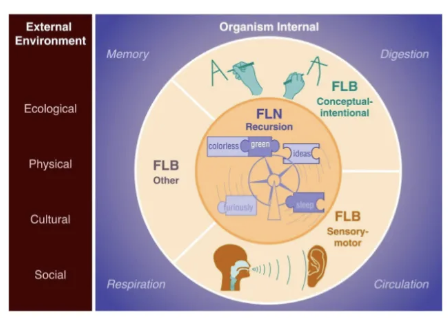
What is Faculty of Language in the Narrow Sense (FLN)?
Refers to specific features unique to human language, like recursion (the ability to embed ideas within ideas) and the complex grammatical structures we can create
Core computational mechanism that builds infinite structures from finite means
What are 3 claims about language?
Language as a thought tool: The primary role of language is to express thoughts, not to communicate. Communication is secondary.
No comparison with animals: Human language is considered qualitatively different from animal communication; it's not just a more complex version.
Species studies caution: Studies in other species may reveal mechanisms (e.g., working memory, pattern recognition) also used in language—but these mechanisms are not exclusive to language.

What does the speech discrimination experiment with monkeys (tamarins) show regarding Faculty of language: Sensory-motor interface?
Goal: To test whether tamarins can discriminate between languages and speakers.
Conditions:
Forward speech (normal)
Backward speech (unnatural)
Tamarins can discriminate between languages when speech is played forward, even though they don't have full language abilities.
This implies that some sensory-motor processing mechanisms (like detecting rhythm or sound patterns) are shared across species, even if full language is not.
It supports the idea that some mechanisms used in language are not exclusive to it
What are two animal examples of Faculty of Language: Conceptual - intentional interface
vervet monkeys use vocalizations to communicate specific meanings—though in a limited, non-linguistic way
honeybees use the waggle dance to explore how information can be encoded and communicated without language
Describe how vervet monkeys are an example for Faculty of Language: Conceptual - Intentional interface
monkeys have different calls for predators → snake alarm is different from eagle alarm
issue: vocalization is limited because they don’t have muscle control and communication is indexical (more instinctive survival instinct)
can only happen in the presence of what is happening
These vocalizations are instinctive and referential (they point to specific dangers), but they:
Lack syntax (no structure or combination rules)
Are not generative (you can’t build new meanings by combining them)
Do not reflect intentional communication like in humans (ex. expressing thoughts or questions)
Vervet calls show that animals may map sounds to meanings, but not in a linguistic way.
This supports the idea that full language depends on a more complex conceptual-intentional interface unique to humans
This slide demonstrates that some precursors to language (like sound-meaning associations) exist in other species. However, only humans use a flexible, abstract, and compositional system tied to internal thought and intentionality—what we call language.
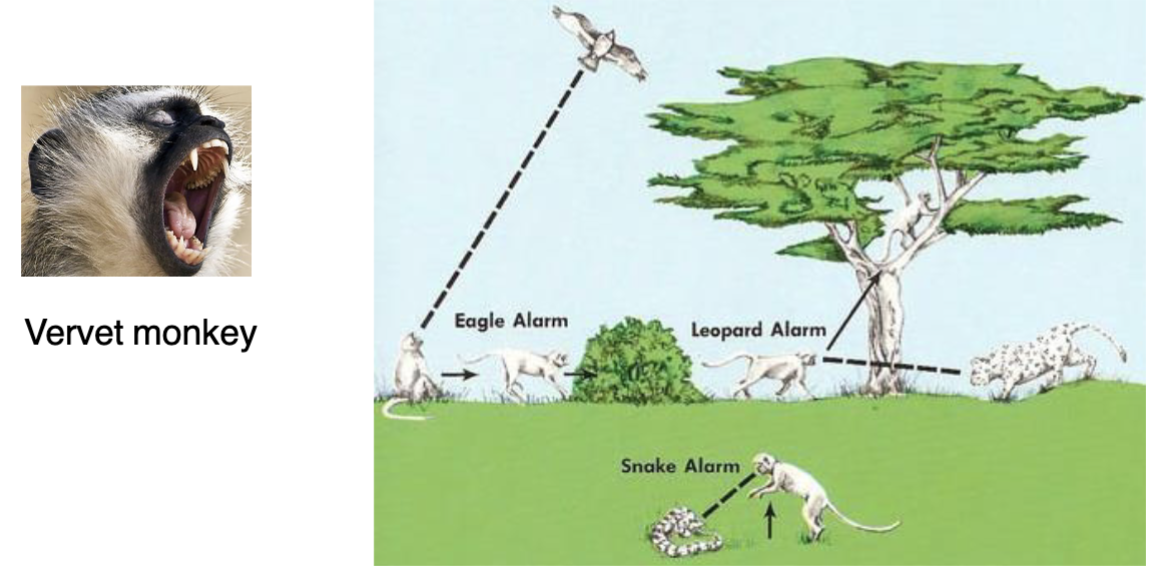
What is the Conceptual - Intentional interface? → faculty of language
The cognitive side of language: where thoughts, intentions, and reasoning occur.
It connects mental concepts with the linguistic system.
In humans, this interface enables us to turn abstract thoughts into structured language.
Describe how honeybees are an example for Faculty of Language: Conceptual - Intentional interface
When a forager bee finds a flower source, it returns to the hive and performs a waggle dance.
The dance communicates:
Direction of the flower (relative to the sun)
Distance (via duration of the waggle)
This is a symbolic communication system—it maps internal representations (location of food) to external signals (dance patterns).
animals can encode and convey conceptual information.
Limitations of the waggle dance:
Is rigid and limited in scope (only about food)
Doesn’t involve syntax or recursive structure
Isn’t generative (bees can’t create new messages beyond what’s hard-coded)
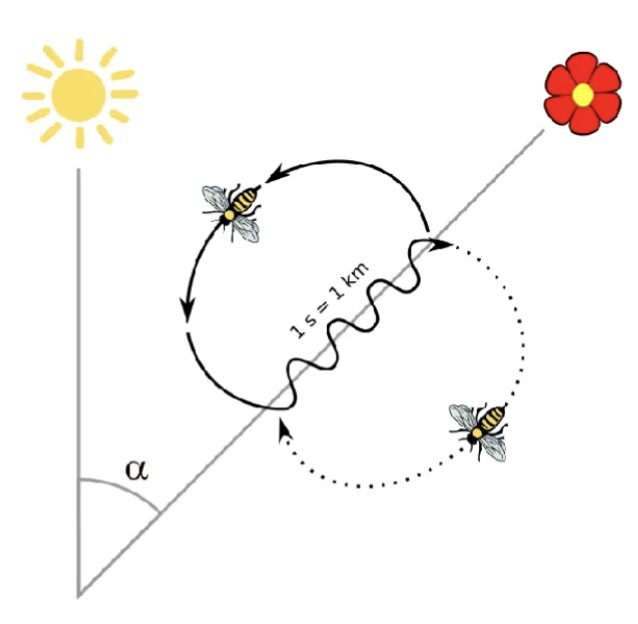
What are makes language uniquely human? (3)
Discrete Infinite Elements (words)
Human language consists of units (ex. words) that are:
Discrete: clearly separable
Infinite in potential: can be combined endlessly
This enables humans to express an unlimited number of ideas using a finite vocabulary.
2. Syntactic Organization (Computation)
These elements are not just listed — they’re structured by rules (syntax).
The mind applies computational operations (like recursion, hierarchy) to build complex expressions.
This syntactic system is what separates language from other forms of animal communication.
3. Symbolism (Lexicon)
Language uses arbitrary symbols (words) to refer to concepts.
These are stored in the lexicon — our mental dictionary.
Symbolic reference is more flexible and abstract than fixed calls or signals seen in animals.

Describe recursion in the Faculty of Language (FLN) → unique human component
Recursion is the ability to embed structures within structures (ex. sentences within sentences).
It’s the computational mechanism at the heart of human syntax.
This is what makes the Faculty of Language in the Narrow Sense (FLN) distinct from broader communication systems seen in animals
Recursion is:
A defining feature of human language
What allows us to generate infinite new expressions from finite elements
Considered absent in non-human species, even those with symbolic or meaningful signals
Describe recursion in the honeybee waggle dance and vocalization in vervet monkeys
The bee waggle dance and vervet monkey calls lack recursion.
They convey fixed messages (e.g., food direction or predator type) but can’t combine or nest them in flexible ways.
How is the Pirahã language, spoken in the Amazon an example of recursion?
Pirahã lacks recursion in its external language (e-language, ex. actual spoken language).
Culture shapes grammar — the Pirahã worldview (focus on the present, rejection of abstraction) may restrict language structure.
Raises the question: might recursion exist in the internal language (I-language, the mental system), even if it's not expressed?
Recursion (the ability to embed phrases within phrases) is seen as a core component of the Faculty of Language in the Narrow sense (FLN) and is often claimed to be unique to humans
emphasizes a key tension in linguistics:
Is recursion truly universal in human language?
Or can culture override an innate computational capacity?
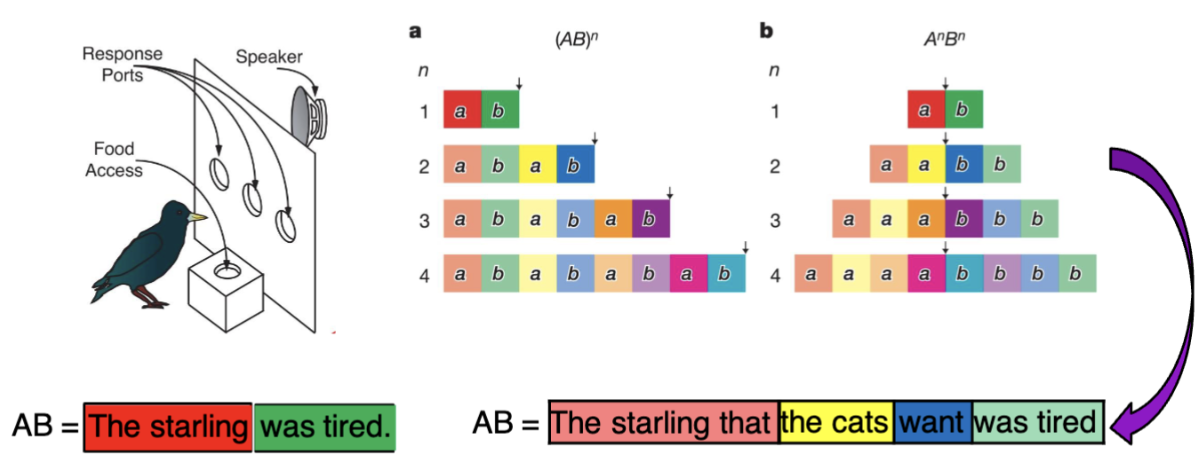
Describe how European Starlings were used to try and show recursion
Starlings were trained to discriminate between patterns of artificial sounds with different grammatical structures.
Two types of sound patterns were tested:
(AB)ⁿ (e.g., ab, abab, ababab) → simple repetition
AⁿBⁿ (e.g., aabb, aaabbb) → more complex nested patterns, suggesting recursion
Setup (left image)
Birds heard sound patterns from a speaker and had to choose the correct response port to get food.
Their choices revealed whether they could distinguish between pattern types.
Results (middle graphs)
The birds learned (AB)ⁿ patterns more easily (simpler repetition).
There was some limited success with AⁿBⁿ patterns, suggesting possible sensitivity to structured sequences.
Human Comparison (bottom examples)
AB structure = “The starling was tired.” (simple sentence)
AⁿBⁿ structure = “The starling [that the cats want] was tired.” (nested/recursive relative clause)
This human sentence involves recursive embedding, which is much more complex than AB repetition. It requires memory, hierarchy, and grammar rules—all tightly linked to syntactic recursion.
While starlings show some pattern learning, the complexity and flexibility of human recursive syntax (like in embedded clauses) still appears qualitatively different.
This supports the view that recursion, as used in human language, remains a uniquely human capacity.
*Birds could have counted or detected acoustic approximation → could have simply learned the patterns
![<ul><li><p class="">Starlings were trained to <strong>discriminate between patterns of artificial sounds</strong> with different grammatical structures.</p></li><li><p class="">Two types of sound patterns were tested:</p><ul><li><p class=""><strong>(AB)ⁿ</strong> (e.g., ab, abab, ababab) → simple repetition</p></li><li><p class=""><strong>AⁿBⁿ</strong> (e.g., aabb, aaabbb) → more complex nested patterns, suggesting recursion</p></li></ul></li></ul><p></p><p>Setup (left image) </p><ul><li><p class="">Birds heard sound patterns from a <strong>speaker</strong> and had to <strong>choose the correct response port</strong> to get food.</p></li><li><p class="">Their choices revealed whether they could <strong>distinguish between pattern types</strong>.</p></li></ul><p class=""></p><p class="">Results (middle graphs) </p><ul><li><p class="">The birds <strong>learned (AB)ⁿ patterns more easily</strong> (simpler repetition).</p></li><li><p class="">There was <strong>some limited success</strong> with AⁿBⁿ patterns, suggesting possible <strong>sensitivity to structured sequences</strong>.</p></li></ul><p class=""></p><p class="">Human Comparison (bottom examples) </p><ul><li><p class=""><strong>AB structure</strong> = “The starling was tired.” (simple sentence)</p></li><li><p class=""><strong>AⁿBⁿ structure</strong> = “The starling [that the cats want] was tired.” (nested/recursive relative clause)</p></li></ul><p> </p><p class="">This human sentence involves <strong>recursive embedding</strong>, which is <strong>much more complex</strong> than AB repetition. It requires <strong>memory, hierarchy, and grammar rules</strong>—all tightly linked to <strong>syntactic recursion</strong>.</p><p class=""></p><ul><li><p class="">While starlings show <strong>some pattern learning</strong>, the complexity and flexibility of <strong>human recursive syntax</strong> (like in embedded clauses) still appears <strong>qualitatively different</strong>.</p></li><li><p class="">This supports the view that <strong>recursion, as used in human language</strong>, remains a <strong>uniquely human capacity</strong>.</p></li></ul><p></p><p>*Birds could have counted or detected acoustic approximation → could have simply learned the patterns</p>](https://knowt-user-attachments.s3.amazonaws.com/1f622346-b200-4773-a1d1-100165ad4e3c.png)
What are 3 uniquely human components of language?
recursion
merge
lexicon
Describe merge in the Faculty of Language (FLN) → unique human component
Merge is a fundamental operation in syntax that:
Combines two elements (like words or phrases) into a new syntactic unit
Is the building block of syntactic structure
Example:
[ate] + [apple] → [ate apple]
This forms hierarchical structure, not just a linear string
Aspects:
Creates syntactic objects (like sentences or phrases)
Allows for syntactic dependencies (ex. subject-verb agreement, word order)
Supports hierarchical sentence structure
Integration with Language System
Merge operates within the syntactic module (blue box)
It interfaces with:
Conceptual-intentional system (meaning/thoughts)
Sensory-motor system (spoken/written/sign language)
![<p><strong>Merge</strong> is a fundamental operation in syntax that:</p><ul><li><p class=""><strong>Combines two elements</strong> (like words or phrases) into a new <strong>syntactic unit</strong></p></li><li><p class="">Is the building block of <strong>syntactic structure</strong></p></li></ul><p class="">Example:</p><ul><li><p class="">[ate] + [apple] → [ate apple]</p></li><li><p class="">This forms <strong>hierarchical structure</strong>, not just a linear string</p></li></ul><p></p><p><strong>Aspects</strong>:</p><ol><li><p class=""><strong>Creates syntactic objects</strong> (like sentences or phrases)</p></li><li><p class="">Allows for <strong>syntactic dependencies</strong> (ex. subject-verb agreement, word order)</p></li><li><p class="">Supports <strong>hierarchical</strong> sentence structure</p></li></ol><p class=""></p><p class="">Integration with Language System </p><ul><li><p class="">Merge operates within the <strong>syntactic module</strong> (blue box)</p></li><li><p class="">It interfaces with:</p><ul><li><p class=""><strong>Conceptual-intentional system</strong> (meaning/thoughts)</p></li><li><p class=""><strong>Sensory-motor system</strong> (spoken/written/sign language)</p></li></ul></li></ul><p class=""></p>](https://knowt-user-attachments.s3.amazonaws.com/0b24d5ba-0cad-45a3-ad9f-bc6f693c7aca.png)
Describe the 4 aspects of lexicon in the Faculty of Language (FLN) → unique human component
The lexicon is the internal mental store of words (lexical items).
Each lexical item includes:
Phonological form (how it sounds)
Syntactic features (how it combines with other words)
Semantic content (meaning)
It’s not just a list—it’s a rich, structured system crucial for producing and understanding language.
Aspects:
Highly complex and specific
Words carry detailed grammatical and conceptual information, unlike animal calls which are typically fixed and limited.
Infinite
Humans can create an unlimited number of new words or meanings using existing elements (e.g., compound words, neologisms, metaphors).
Mind-dependent entities
Lexical meaning is not just referential—it often reflects mental representations, emotions, or abstract concepts.
Enables interpretation of the world
Words are tools for categorizing and reasoning about experience, not just for communication.
System Interaction (diagram)
The lexicon is housed in the syntactic system (blue box).
It interacts with:
The conceptual-intentional system (orange): to encode thoughts into words
The sensory-motor system (red): to express those words in speech/sign

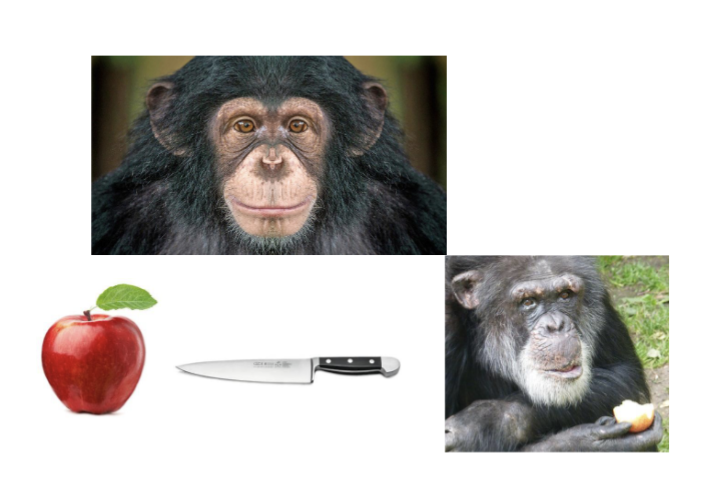
Decribe chimps and Lexicon → unique human component of Language (4)
While chimps can:
Recognize objects (ex. apple, knife)
Use tools
Learn some symbolic associations (via signs or lexigrams)
They lack a lexicon in the human linguistic sense:
1. Highly complex and specific
Human words encode rich syntactic and semantic features.
Chimps recognize objects but don’t assign roles or relationships linguistically.
2. Infinite
Humans can endlessly create and combine words (ex. “knife apple cutter,” “pre-cuttable apple”).
Chimps show no evidence of productive, generative word creation.
3. Mind-dependent entities
Human words can refer to things that don’t exist (ex. “unicorn,” “justice”).
Chimps communicate only about immediate, concrete entities.
4. World interpretation
Language lets humans categorize, explain, and narrate the world.
Chimps can act on the world but do not show evidence of representing it symbolically in structured ways.
🐒 Visual Message of the Slide
The chimp with an apple and knife suggests tool use and object recognition.
But it cannot label, describe, or reflect on the experience using language.
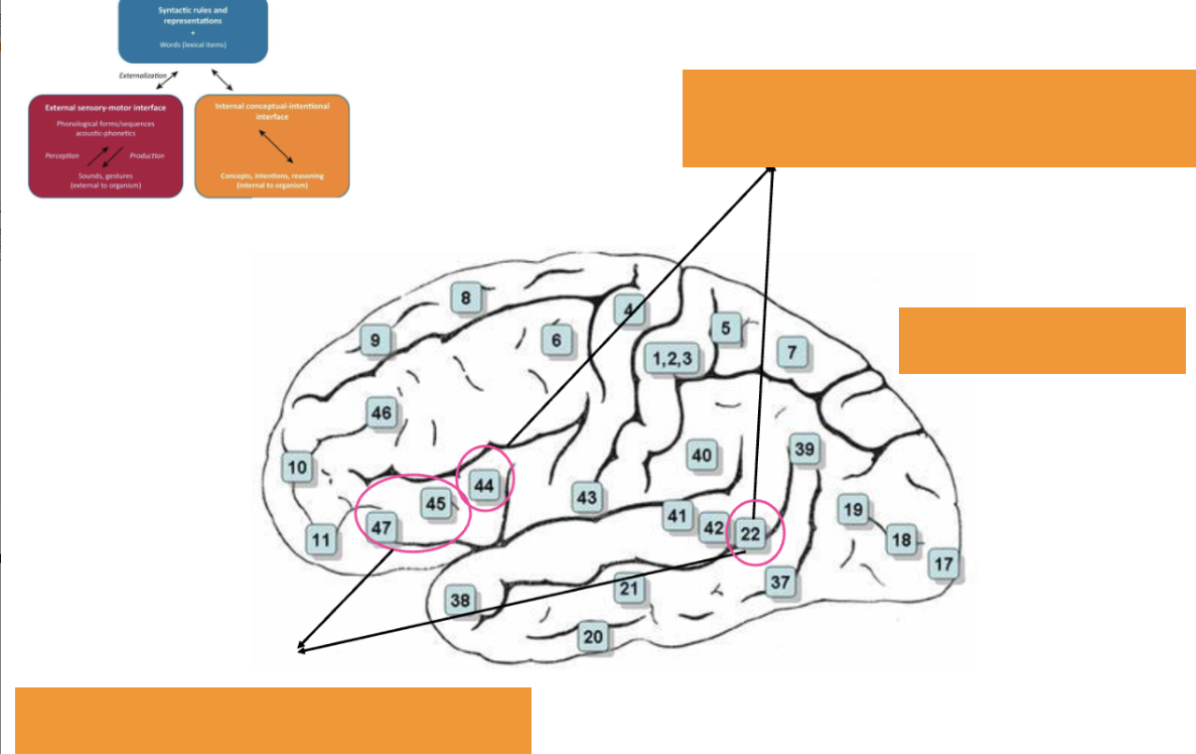
Neural architecture
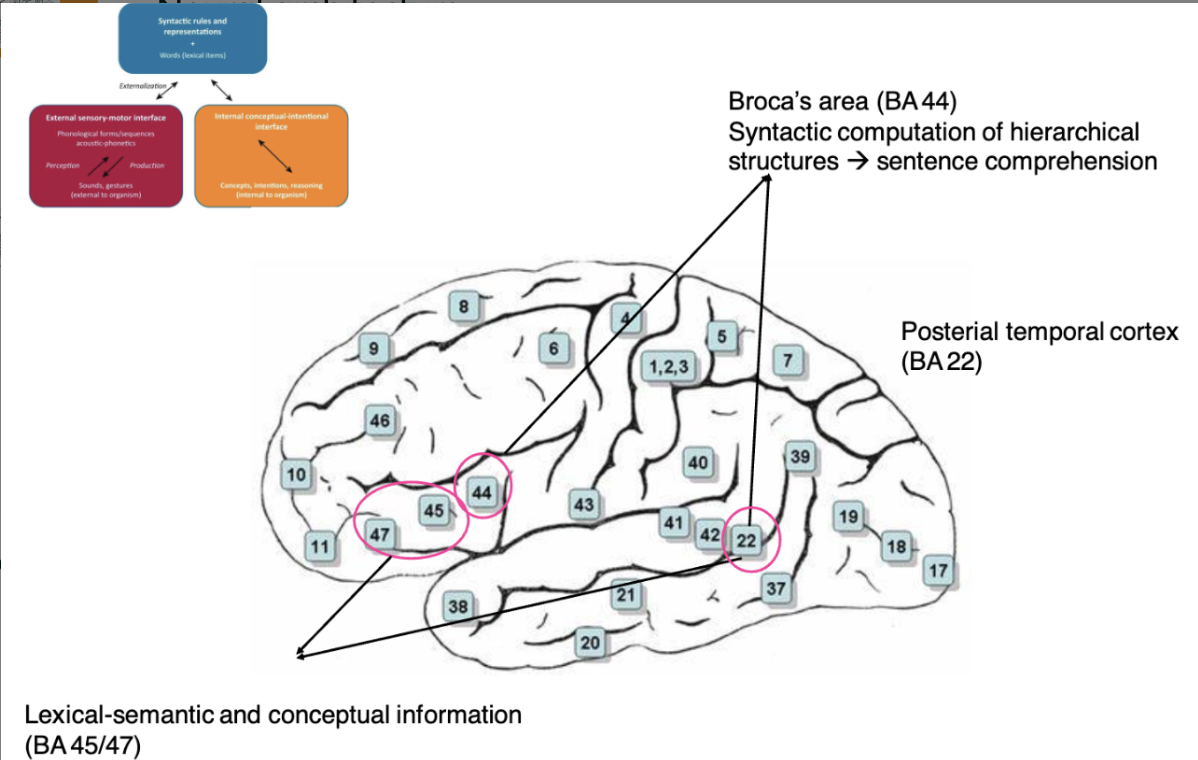
What are the three major components of language?
Sensory-Motor Interface (FLB)
How language is externalized (speech, sign)
Includes:
Speech discrimination (Ramus et al. 2000 – tamarins)
Vocalization (Owren & Bernacki, 1988 – vervet monkeys)
2. Conceptual-Intentional Interface (FLB)
Interface between language and thought
Includes:
Vocalization again (ex. vervet monkey calls as meaningful signals)
3. Computation Core (FLN)
Syntax and recursion
Merge as the core operation (Berwick et al., 2013)
Enables hierarchical structure